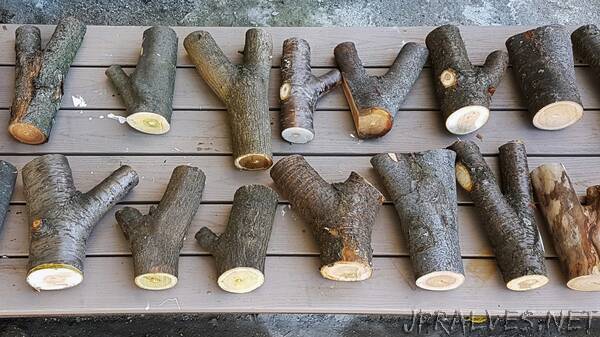
“Discarded tree forks could replace load-bearing joints in architecture projects using a construction technique developed by researchers at the Massachusetts Institute of Technology.
The system combines generative design and robotic fabrication to allow tree forks – the pieces of wood where a trunk or branch splits into two – to be used as the Y-shaped nodes that connect straight building elements.
Created by the Digital Structures research group at the Massachusetts Institute of Technology (MIT), the five-step approach has already been used to install a demonstration structure on the university’s campus, with a larger pavilion now in the works.
The researchers believe their system could reduce the environmental impact of construction by offering a replacement for high-strength but emissions-intensive virgin materials such as steel, which are usually needed to form structural components.
In comparison, tree forks are not just natural and renewable but also a reclaimed waste product from the timber industry, which uses only the straight sections of trees to create furniture and building materials.
Caitlin Mueller, associate professor in the Building Technology programme at MIT and leader of the Digital Structures research group, describes tree forks as “naturally engineered structural connections” that can transfer force very efficiently thanks to their internal fibre network.
“The greatest value you can give to a material is to give it a load-bearing role in a structure,” she told university newspaper MIT Energy Initiative.
“If you take a tree fork and slice it down the middle, you see an unbelievable network of fibres that are intertwining to create these often three-dimensional load transfer points in a tree,” she continued.
“We’re starting to do the same thing using 3D printing but we’re nowhere near what nature does in terms of complex fibre orientation and geometry.”
The first step in the five-step workflow developed by Mueller and her Digital Structures team involves cataloguing a selection of tree forks into a digital library. This is done by 3D scanning and can be completed with readily available equipment such as a smartphone app.
These scans capture the relative geometry and orientation of the branches, which determine a fork’s internal fibre orientation and therefore its strength.
The second step involves matching the tree forks to the Y-shaped nodes in a given architectural design. This is achieved through algorithms that assess how well the shape of a particular tree fork lines up with a given node, and then adjust the overall distribution of tree forks to make the most efficient use of the inventory.
In the third step, designers can play with the shape of the structure, knowing that the algorithm used for the matching process will recalculate the optimal tree fork distribution as they go.
The software developed by the Digital Structures team automatically generates designs that give the best “matching score” but also allows designers to override these designs with their own preferences.
Once the design is finalised, the fourth step involves cutting the tree forks as minimally as possible to strip off the bark and make the joint fit in its assigned node.
This stage is also automated, with an algorithm generating the code instructions and, in the case of the demo structure, robots at the Autodesk Technology Center Boston cutting the wood.
In the final and only low-tech step, the structure is manually put together “like a child’s toy set”, with each tree fork labelled to allow for straightforward assembly.
Mueller believes that, just like with current computational design processes, this system could ultimately enable architects to explore new forms.
“Many iconic buildings built in the past two decades have unexpected shapes,” she said. “Tree branches have a very specific geometry that sometimes lends itself to an irregular or nonstandard architectural form-driven not by some arbitrary algorithm but by the material itself.”
Timber has become an increasingly popular choice as the architecture and construction industries attempt to reduce their embodied carbon emissions from materials and construction.
A fully-grown tree is estimated to remove 22 kilograms of CO2 from the atmosphere over the course of a year, meaning that the material is carbon negative as long as it is responsibly sourced and used.
One of the key problems to be solved in realising the sustainable potential of wood is the large amount of unused offcuts produced by the timber industry, along with issues surrounding transport and processing.”
